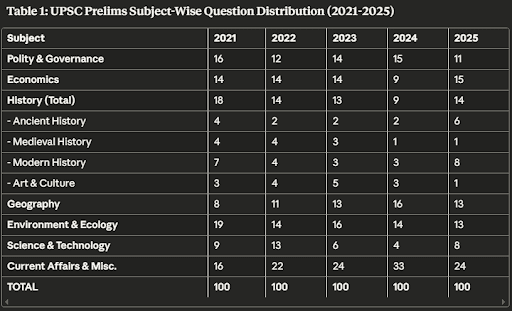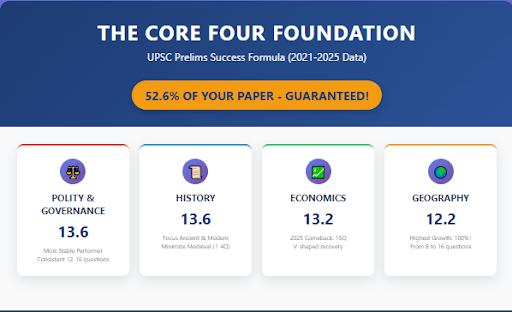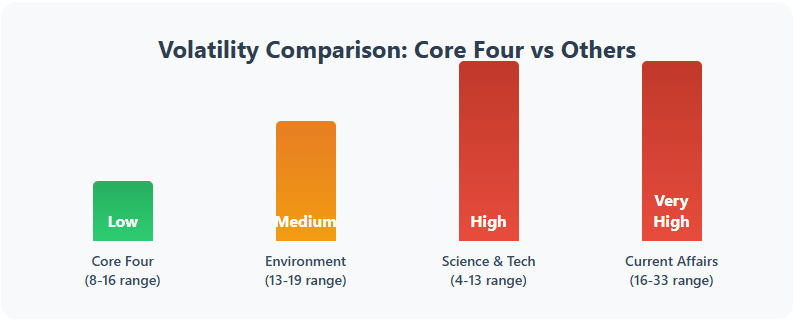UPSC Prelims Subject-Wise Weightage (2021–2025)
8 min read
Nov 05, 2025

TL;DR
Core Four = 52.6% of the paper (Polity, History, Economy, Geography).
Static vs CA: ~66–70% static; ~30–34% Current Affairs (often testing static concepts).
Ranges (2021–2025): Polity 11–16; History 9–18; Economy 9–15; Geography 8–16; Environment 13–19; S&T 4–13; CA 16–33.
Complete Five-Year PYQ Analysis Subject Wise

Overall Insights: The Big Picture
1. The Core Four Foundation - Your 52.6% Guarantee

Four subjects consistently form the bedrock of UPSC Prelims success:
- Polity & Governance: 13.6 average (most stable performer)
- History: 13.6 average (focus on Ancient & Modern, minimize Medieval)
- Economics: 13.2 average (strong 2025 comeback to 15 questions)
- Geography: 12.2 average (highest growth trajectory)
Critical Insight: These four subjects alone account for 52.6% of the paper. Master them with 80% accuracy, and you can essentially secure 80+ marks before touching other subjects.This is already near cut off range of past 3 years 87.98(2024), 75.41(2023) and 88.22(2022).This will boost your confidence immensely to take risks in other subjects. This is not a strategy; it's simple mathematics.
2. The Core Four - Why These 4 Subjects?

The data clearly identifies four subjects as the foundation of UPSC Prelims success:
The Numbers Speak:
- Combined Average: 52.6 questions (52.6% of the paper)
- Consistency: All four maintain 12-14 questions average over 5 years
- Stability: Less volatile compared to S&T (4-13 range) or Current Affairs (16-33 range)
- Predictability: Even in their variations, they never drop below critical mass
Individual Strengths:
- Polity (13.6 avg): Most stable, conceptual understanding translates directly to marks
- History (13.6 avg): Despite internal variations, total questions remain substantial
- Economics (13.2 avg): 2025's bounce-back to 15 questions confirms continued importance
- Geography (12.2 avg): Highest growth trajectory, increasing importance
Why Environment Isn't Core Despite 15.2 Average:
- Heavily current affairs integrated (harder to master through pure static study)
- More volatile in nature of questions and requires updating with current affairs, therefore can not be completely covered in initial phases.
The Strategic Logic:
- Master these 52-53 questions with 80% accuracy = 80+ Marks achieved in Prelims
- Add reasonable performance in other areas = Comfortable prelims clearance
- These subjects have the best ROI (Return on Investment) of preparation time
3. Current Affairs - The Parallel Track Philosophy
Current Affairs (averaging 23.8 questions) represents a paradigm shift in how UPSC tests knowledge. It not only includes pure current affairs but also static linked or inspired questions from current affairs. If we take both direct and indirect current affairs related questions its weightage easily increases to around 40%.
Not a subject but a lens: View all static topics through current developments & vice versa.
The multiplier effect: Current context makes static knowledge more scoreable
Daily habit, not sprint: 1-1.5 hours daily for 12 months > 10 hours daily in last month
Integration is key: Every news item should trigger recall of related static concepts
4. The Volatility Lessons

Some subjects show extreme swings that offer important lessons:
- Geography: 8→16 questions (100% increase) shows no subject should be underestimated
- S&T: 13→4→8 questions warns against both over-preparation and complete neglect
- Art & Culture: 3-5→1 question crash proves UPSC's unpredictability
- Modern History: 3→8 questions surge rewards those who maintain comprehensive coverage
It is advised to at least do the minimum essential even in low priority subjects and not totally neglect any subject.
5. The Minimization Strategy
Data clearly shows where NOT to spend excessive time:
- Medieval History: Consistently 1-4 questions (lowest in History)
- Art & Culture: Crashed to 1 question in 2025
- Miscellaneous: Unpredictable, cannot be specifically prepared for
- Combined: These three areas average just 6-7 questions - prepare basics only
6. The 70-30 Distribution Reality
Traditional static subjects maintain 66-70% weightage, while Current Affairs occupies 30-34%. But remember: even the 30% current affairs questions require 70% static knowledge to answer correctly. This reinforces why Core Four mastery is non-negotiable.
Prioritization Strategy: Smart Resource Allocation
Tier 1: The Four Foundation Pillars (Must Score 80%+)
Allocation: 45% of preparation time
These four subjects form the bedrock of UPSC Prelims, averaging 52-54 questions combined:
- Polity & Governance (11-16 questions) - Most consistent performer
- History (9-18 questions) - Focus on Ancient & Modern, minimize Medieval
- Geography (8-16 questions) - Highest growth trajectory
- Economics (9-15 questions) - Strong bounce-back in 2025
Combined Average: 52.6 questions (52.6% of paper)
Tier 2: High-Yield Subjects (Target 75%+)
Allocation: 25% of preparation time
- Environment & Ecology (13-19 questions) - Highest among individual subjects
- Science & Technology (4-13 questions) - Despite volatility, maintain competence
Combined Average: 23.2 questions
Tier 3: Selective Focus (Target 70%+)
Allocation: 10% of preparation time
- Art & Culture (1-5 questions) - Crashed to 1 in 2025, minimal focus
- Medieval History (1-4 questions) - Consistently lowest, cover basics only
- Miscellaneous Topics - Unpredictable, rely on general awareness
Parallel Track: Current Affairs Integration (Daily Commitment)
Allocation: 1-1.5 hours daily throughout preparation
Current Affairs (24-33 questions) is NOT a separate subject but a lens through which all subjects are viewed:
- Daily: 1 hour newspaper + subject tagging
- Weekly: Integration with static subjects during revision
- Monthly: Consolidation and compilation review
- Continuous: Link every static topic with recent developments
Key Insight: Current Affairs questions often test static concepts through contemporary events. Master the static foundation first, then current affairs become easier to understand and retain.
Preparation Tips: Strategic Approach
1. The 80% Accuracy Formula for Core Four

The Mathematics of Success:
- 4 Core Subjects Average: 52.6 questions
- Target Accuracy: 80% i.e 4 out of 5 questions should be correct.
- Expected Score: 80+marks from core subjects alone
- Add Environment: 13-15 questions with 75% accuracy = 20+ Marks
- Total: 100+marks, Well above the cut off range of the past 3 years 87.98(2024), 75.41(2023) and 88.22(2022). (clearing prelims becomes highly probable)
How to Achieve 80% in Core Four:
- Multiple Revisions: Minimum 4 complete revisions
- PYQ Mastery: Solve last 15 years questions topic-wise for each subject
- Conceptual Clarity: Focus on understanding, not memorization
- Multiple Mocks: Sectional, Revision and Full Length Tests to test yourself and improve.
- Error Analysis: Maintain mistake notebook and revise frequently
2. The 3-Stage Reading Strategy
Stage 1 - Foundation (4 Months )
Complete static syllabus from standard books. Build conceptual clarity. Helps in understanding current affairs better in Stage 2.
Stage 2 - Current Affairs Integration (4 Months Onwards)
Daily newspaper analysis (1 hours) with monthly current affairs compilation on weekends or 4-5 days/month. Backlink current events with static concepts for integration as well as revision.
Stage 3 - Revision & Practice (3 Months Before Prelims)
Subject-wise revision - 4 rounds minimum on an average. For strong subjects which are conceptual in nature can do 2 revisions. For highly factual areas at least 4 revisions are required in the last 3 months for active recall.
Indepth previous year paper analysis and solution including the options and statements for revision and filling gaps in knowledge and tracking key patterns in current affairs.
30+ mock tests including sectional, revision and full length for GS Paper I and 10+ Mock Tests for CSAT. Each mock test should be followed by indepth post test analysis to improve upon mistakes, revise and cover knowledge gaps.
3. Current Affairs as a Multiplier, Not a Subject
Current Affairs is not something to be "studied" but to be "integrated":
Wrong Approach:
- Treating Current Affairs as a separate subject
- Accumulating monthly magazines without revision
- Memorizing facts without understanding context
Right Approach:
- Read news through the lens of your static knowledge
- Example: Budget news → Link with Economics concepts already studied
- Example: Supreme Court judgment → Connect with Polity articles
- Example: Archaeological discovery → Relate to Ancient History
- Example: Climate summit → Apply Environment concepts
The Integration Formula:
- Static Knowledge (70%) + Current Context (30%) = Complete Answer
- Never study current affairs in isolation
- Always ask: "Which static concept does this relate to?"
Current Affairs Mastery Plan
- Daily: Read newspaper (1 hours) - Focus on important Current affairs themes based on PYQ & Static Part
- Weekly: Revise key Prelims Topics while linking with static
- Monthly: Revise and consolidate monthly compilations
- Quarterly: Revise subject wise all the months current affairs
- Last 2 Months: Revise last 12 months' current affairs twice
4. Red Flags to Avoid
- Don't ignore Current Affairs thinking "I'll cover it in the last 2 months"
- Don't skip Environment assuming it's mostly current affairs
- Don't over-focus on Science & Technology given its declining trend
- Don't study Ancient/Medieval History in excessive detail
- Don't neglect map work in Geography
5. Success Mantras
- Consistency over Intensity: 6 hours daily for 12 months > 12 hours daily for last 3 months
- Analysis over Attempts: Analyzing 30 mocks > Attempting 100 mocks without analysis
- Understanding over Memorization: Conceptual clarity scores better than rote learning
- Integration over Isolation: Connected learning yields better retention
- Revision over New Reading: 3 revisions of limited sources > Reading 10 books once
Conclusion: Adapting to Evolution
The UPSC Prelims pattern from 2021 to 2025 clearly indicates a paradigm shift toward current affairs integration while maintaining the significance of traditional subjects. Success requires:
- Static Mastery: Master the core static subjects with multiple revisions and PYQs to have 80%+ accuracy.
- Dynamic Preparation: Adapting to changing patterns while maintaining comprehensive coverage
- Strategic Focus: Prioritizing based on weightage trends without completely ignoring any area
- Integrated Learning: Seamlessly blending static knowledge with contemporary developments
- Consistent Effort: Regular study, revision, and practice throughout the preparation journey
Remember, while this data provides valuable insights for strategic preparation, UPSC retains the flexibility to modify patterns. Use these trends as guidelines to optimize your preparation, but ensure comprehensive coverage of the entire syllabus.
FAQs (Frequently Asked Questions)
Q1. What are the “Core Four” subjects in UPSC Prelims subject-wise weightage?
Polity & Governance, History, Economics, and Geography. Together they average ~52.6% of the paper and are the most stable areas to secure marks.
Q2. Why is Environment not part of the Core Four despite a high average?
It’s heavily integrated with current affairs, more volatile in question nature, and requires continuous updating compared to static subjects.
Q3. How should Current Affairs be approached?
Treat Current Affairs as a lens, not a separate subject. Maintain a daily habit (about 1–1.5 hours), integrate with static topics weekly and monthly, and link news to static concepts.
Q4. Which areas should be minimized?
Medieval History, Art & Culture (noting the 2025 drop), and Miscellaneous due to unpredictability—cover basics and avoid excessive time.
Q5. What is the 70–30 distribution reality?
Static subjects hold roughly 66–70% of the paper, while Current Affairs is 30–34%. Even CA questions often require ~70% static knowledge.
Q6. What’s the high-level study plan ?
Three stages: Foundation (static), Current-Affairs Integration, and Revision & Practice (with PYQs and 30+ mocks), plus continuous error analysis.